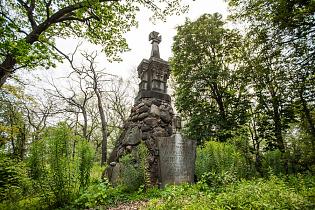Hidden Toronto: John Howard’s tomb
What
John G. Howard’s tomb
Where
High Park
Why you should check it out
Erected on a reserved section of High Park in anticipation of the death of his ailing wife, Jemima, John Howard’s tomb, aka The Architect’s Tomb, is a popular stop on High Park’s annual haunted Halloween walks. It’s near Colborne Lodge, the Howards’ former country home where, legend has it, the ghost of Jemima still haunts the bedroom where she lived out her last years behind barred windows and a locked door.
Besides its ghostly history, the massive tomb has also come to symbolize one of old Toronto’s most enduring – and tragic – love stories.
The Howards immigrated from England in 1832 after John accepted an appointment as a drawing master at Upper Canada College.
They settled on some 80 hectares of what was supposed to be a sheep farm that stretched from Lake Shore to Bloor Street. It was there that they built their country home known as Colborne Lodge. The Regency-style home was designed by Howard and named after Lieutenant-Governor of Upper Canada John Colborne, who is credited with giving Howard his start in architecture in Canada.
Howard was the city’s first professional architect and official surveyor and civil engineer. He is credited with laying out many of the natural landmarks we recognize today. Among them: Toronto Harbour, Toronto Islands and the Esplanade – the boardwalk envisioned for the waterfront near present-day St. Lawrence Market. He was also an amateur painter of some note, as was Jemima.
Howard would sometimes while away the day painting the natural surroundings of their country estate, while Jemima reportedly favoured romantic themes. Theirs was an outwardly charmed existence. But one can only wonder.
Howard lived a double life. It was apparently known to the townspeople that he kept a mistress, Mary Williams, with whom he fathered three children. Whether that was known to Jemima is unclear, but the couple never had children of their own. In Incidents In The Life Of John G. Howard, a biography based on entries in his journal, their marriage is described as a “singularly happy one.”
Howard’s journal makes no secret of his double life. It includes references to Christmases spent with his other family.




